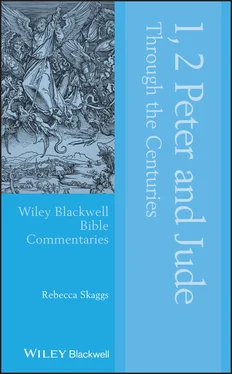One of the issues which interests the early writers is whether the belief of the Old Testament prophets in the promises of God is as inspired as those who lived at the time of Jesus. Clement of Alexandria considered the Old Testament prophets to be foundational to understanding the New Testament work of Christ; he adds: “the prophets have inquired and searched diligently, and … [it] is declared by this that the prophets spoke with wisdom, and that the Spirit of Christ was in them, according to the possession of Christ, and in subjection to Christ” ( Adumbrations : FC: ccel.org).
Oecumenius also understands the Old Testament prophecies as the work of the Spirit of Christ: “The Spirit of Christ predicted his sufferings to Isaiah (Isa. 53:7), and he predicted the resurrection to Hosea” (Hos. 6:3) ( Comm. on 1 Peter , PG 119: 520: my tr.).
Andreas concurs ( Catena , CEC 44). Didymus the Blind explains that at his time (fourth century) this was a debated issue, and explicitly remarks that the opinion held by many that the promises and salvation of the Old Testament prophets were inferior to those of the ones who saw Jesus in the flesh “is false.” He explains further that Christ comes in two ways. One is by the intellect as Divine Word; the other is through the senses as when he appeared on earth historically ( Comm. on 1 Peter , PG 39: 1757–1758).
Theodoret of Cyr (393–458/466) agrees and states emphatically: “Peter says that whatever was announced to you through the proclamation of the Holy Spirit [through the prophets] was sent from heaven” ( Catena , CEC: 45–6: my tr.). Ambrose of Milan (c. 340–397) agrees ( Letters to Laymen 66: FC: ccel.org).
Later, for Luther, the issue continues to focus on the relation between the Old and New Testaments:
Thus the books of Moses and the prophets are the Gospel, since they have first preached and written of Christ that which the Apostles afterward preached and wrote. Yet there is a distinction between them [the Old and New Testaments]. For although both … have been written out on paper, yet … the New Testament, cannot be said so properly to be written, but to have consisted in the living voice which published it. (Luther, Comm .: ccel.org)
Calvin similarly takes a positive view of the prophets and the Old Testament:
This passage [1 Peter 1:10‐12] has been strangely perverted by fanatics, so as to exclude the fathers, who lived under the Law, from the hope of eternal salvation … but [It] teaches us that … they indeed by faith tasted those things which the Lord has passed on by their hands. ( Comm ., 1963: 241)
The writers of the French Confession (1559, 1571) affirm that “the word contained in these [Old Testament] books has proceeded from God” (Pelikan II, IV: 376).
In 1869, Jane Borthwick (1813–1897) communicated this relation of the prophets to the fulfillment and the ultimate unity that results in Christ (1:10) in the words of the hymn, “Hasten the Time Appointed.” The hymn concludes with the joy anticipated in the future:
Hasten the time appointed,
By prophets long foretold
When all shall dwell together,
One Shepherd and one fold.
Let every idol perish,
To moles and bats be thrown
And every prayer be offered
To God in Christ alone.
Let Jew and Gentile, meeting
From many a distant shore
Around one altar kneeling,
One common Lord adore.
Let all that now divides us
Remove and pass away,
Like shadows of the morning
Before the blaze of day.
Let all that now unites us
More sweet and lasting prove
A closer bond of union,
In a blest land of love.
Let war be learned no longer,
Let strife and tumult cease,
All earth His blessed kingdom
The Lord and Prince of Peace.
O long expected dawning,
Come with thy cheering ray!
When shall the morning brighten,
The shadows flee away?
O sweet anticipation!
It cheers the watchers on
To pray, and hope, and labor,
Till the dark night be gone.
( cyberhymnal.org)
Ralph Waldo Emerson (1803–1882) was an American philosopher, essayist, and transcendentalist poet. Although he is best known for his humanist writings, such as “Self‐Reliance,” he was deeply interested in spirituality and ethics ( biography.comwebsite). Emerson was intensely interested in the “Spirit’s involvement in the New Testament writings” (1992: 269–270). At the dedication of the Second Church vestry in Boston, Mass. on February 28, 1831, he specifies that one of the purposes of the dedicated hall was to provide a place for the work of the “Spirit of the New Testament, not the letter.” The attraction of the gospel, according to Emerson, is the love that “glows in its pages … when it teaches the humble believers that God is love … that God dwelleth with the humble [Mt 18.4; Js 4.6 and 1 Pet 5.5] … that we should be holy as he is holy [1 Pet 1.16]. ”
The Interest of Angels (v.12b)
From an early time, a number of church writers have commented on the curious notion that angels themselves are intrigued by Christ’s work of redemption. Clement of Alexandria is one of the earliest leaders to comment on the role of angels in 1 Peter; these angels are not the fallen angels, but “angels who desire to obtain the advantage of that perfection” ( Adumbrations : FC: ccel.org). Irenaeus says, “There is one Son who accomplished the Father’s will and one human race in which the mysteries of God are accomplished, which angels long to behold” ( Against Heresies 5.36.3: LCC 1: 379).
Hilary of Arles has the perspective that the angels are interested because of their great love ( Intro. Comm. on 1 Peter ., PLS 3:86). Niceta of Remesiana (335–414) asks, “If the angels desire to look upon him, should not [human beings] be all the more afraid to despise him?” ( Power of the Holy Spirit , 19. FC: 7:39: ccel.org).
The issue slightly shifts by the time of the Reformation; for example, Calvin approaches this subject from a different angle:
The meaning of this passage [about the angels] can be … either that the treasure we have in the Gospel fills the angels with a desire to see it … or that they anxiously desire to see the kingdom of Christ. ( Comm ., 1963: 242)
In the Middle Ages there was a strong interest in angels, particularly in the Catholic tradition. St. Thomas Aquinas in fact did so much work on angels that he became known as the “doctor of angels” (Catholic Encyclopedia online). He explains angels’ desire to know about salvation in terms of potentiality and actuality:
An angel’s intellect can be in potentiality with regard to things learnt by natural knowledge; for he is not always actually considering everything that he knows by natural knowledge. But as to the knowledge of the Word … he is always actually beholding the Word, and the things he sees in the Word. (ST FP Q [64] A [1])
St. Francis de Sales, showing some influence by St. Thomas, explains the interest of angels (1 Pet. 1:12): “The angels who see the Redeemer and in him all the mysteries of our salvation, do yet desire to see him.” They see him continually, “with a view so agreeable and delightsome” that although they are satisfied, their desire does not diminish; in fact, it increases (PC).
Pelikan and Hotchkins suggest that the biblical tradition of angels as messengers and servants of God eventually became linked to Jewish speculations about angels and the gnostic cosmologies which understood aeons and daimons as mediators between God and humans (2003: 133).
Читать дальше












